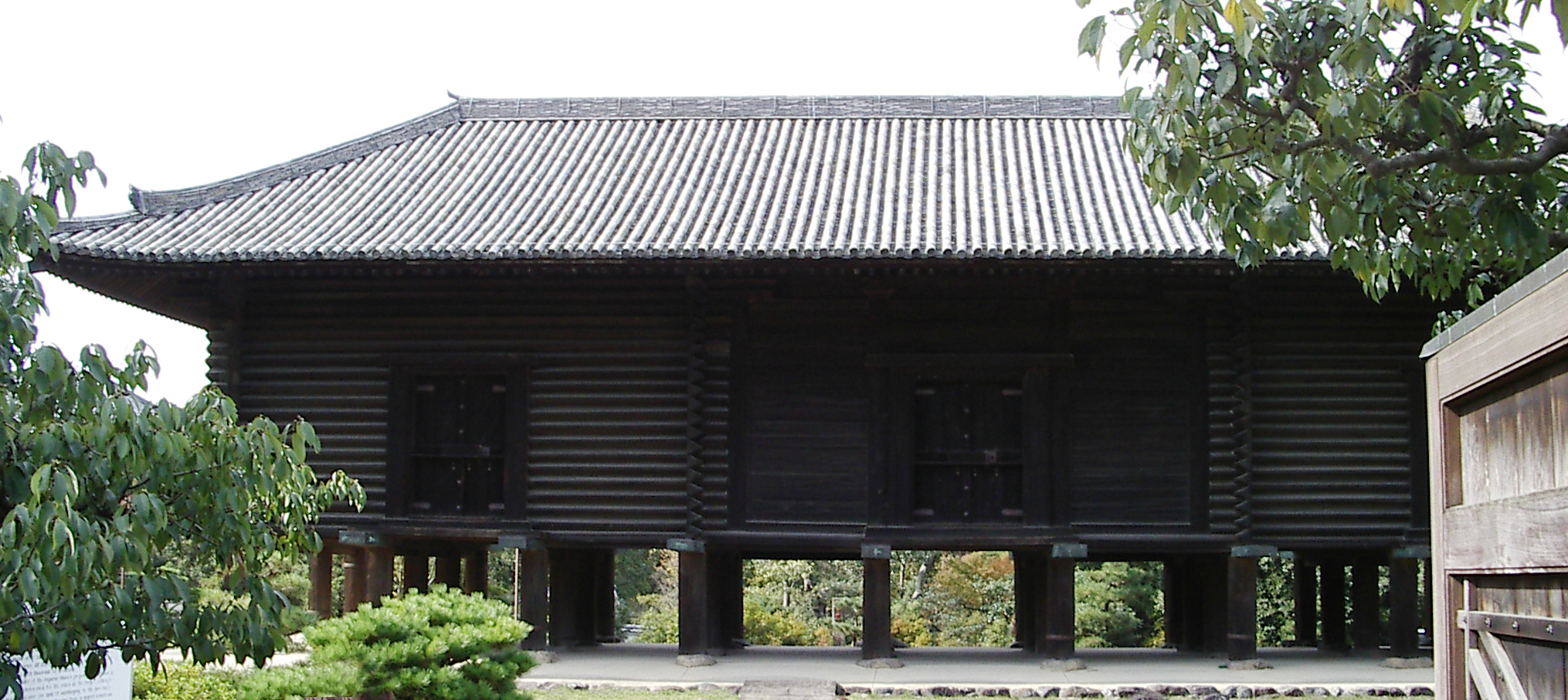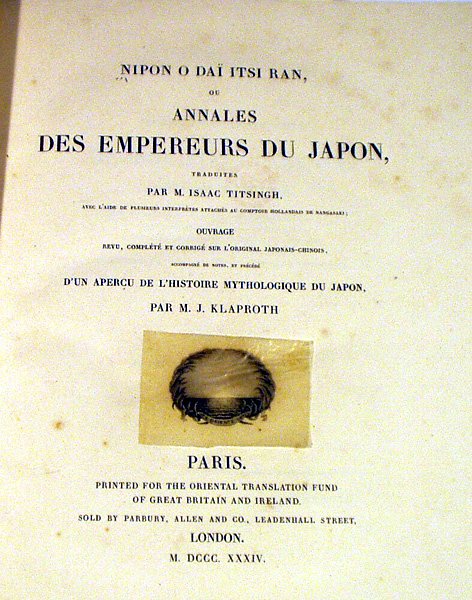|
Gangyō
, also known as Genkei, was a after '' Jōgan'' and before '' Ninna.'' This period spanned the years from April 877 through February 885. The reigning emperor was . Change of era * January 18, 877 : The new era name was created to mark an event or series of events. The previous era ended and the new one commenced in ''Jōgan'' 19, on the 16th day of the 4th month of 877. Events of the ''Gangyō'' era * January 20, 877 (''Gangyō 1, 3rd day of the 1st month''): Yōzei was formally enthroned at age 8; and the beginning of a new ''nengō'' was proclaimed. However, the new residence being constructed for the emperor had not been completed; and initially, he had to live elsewhere in the palace compound.Titsinghp. 122./ref> * 877 (''Gangyō 1, 2nd month''): Ambassadors from Korea arrived in Izumo Province; but they were turned back. * 877 (''Gangyō 1, 6th month''): There was a great drought; and sacrifices were made at the temples of Hachiman, Kamo and other temples in Ise Provin ... [...More Info...] [...Related Items...] OR: [Wikipedia] [Google] [Baidu] |
Emperor Yōzei
was the 57th emperor of Japan,Imperial Household Agency (''Kunaichō'') 陽成天皇 (57)/ref> according to the traditional order of succession. Yōzei's reign spanned the years from 876 through 884. Traditional narrative Before his ascension to the Chrysanthemum Throne, his personal name (his ''imina'') was Sadaakira ''Shinnō'' (貞明親王). Yōzei was the oldest son of Emperor Seiwa. His mother was the Empress Fujiwara no Takaiko, who was also known after Seiwa's abdication as the Nijō empress. Yōzei's mother was the sister of Fujiwara no Mototsune, who would figure prominently in the young emperor's life.Titsingh, p. 121. In ancient Japan, there were four noble clans, the ''Gempeitōkitsu'' (源平藤橘). One of these clans, the Minamoto clan (源氏) are also known as Genji, and of these, the ''Yōzei Genji'' (陽成源氏) are descended from the 57th emperor Yōzei. Yōzei had nine Imperial children, born after he had abdicated.Brown, p. 288. He is said to h ... [...More Info...] [...Related Items...] OR: [Wikipedia] [Google] [Baidu] |
Ninna
was a after '' Gangyō'' and before '' Kanpyō.'' This period spanned the years from February 885 through April 889. The reigning emperors were and . Change of era * January 20, 885 : The new era name was created to mark an event or series of events. The previous era ended and the new one commenced in ''Gangyō'' 9, on the 21st day of the 2nd month of 885. Events of the ''Ninna'' era * January 11, 887 (''Ninna 2, 14th day of the 12th month''): Kōkō traveled to Seri-gawa to practice falconry. He very much enjoyed this kind of hunting, and he often took time for this kind of activity. * September 17, 887 (''Ninna 3, 26th day of the 8th month''): Kōkō died at the age of 57. Kōkō's third son received the succession (''senso''). Shortly thereafter, Emperor Uda formally acceded to the throne (''sokui'').Brown, p. 289; Varley, p. 44; a distinct act of ''senso'' is unrecognized prior to Emperor Tenji; and all sovereigns except Jitō, Yōzei, Go-Toba, and Fushimi have ''senso ... [...More Info...] [...Related Items...] OR: [Wikipedia] [Google] [Baidu] |
Fujiwara No Mototsune
, also known as , was a Japanese statesman, courtier and aristocrat of the early Heian period.Nussbaum, Louis-Frédéric. (2005). "Fujiwara no Mototsune" in ; Brinkley, Frank ''et al.'' (1915). He was the first '' kampaku'', a regent of an adult emperor, in Japanese history''.'' Biography He was born the third son of Fujiwara no Nagara, but was adopted by his powerful uncle Fujiwara no Yoshifusa, who had no sons. Mototsune followed in Yoshifusa's footsteps, holding power in the court in the position of regent for four successive emperors. Mototsune invented the position of '' kampaku'' regent for himself in order to remain in power even after an emperor reached maturity. This innovation allowed the Fujiwara clan to tighten its grip on power right throughout an emperor's reign. Mototsune is referred to as ''Shōsen Kō'' (昭宣公) (posthumous name as Daijō Daijin). Career * 864 ('' Jōgan 6''): Mototsune was named ''Sangi'' * 866 (''Jōgan 8''): '' Chūnagon'' * 870 (' ... [...More Info...] [...Related Items...] OR: [Wikipedia] [Google] [Baidu] |
Jōgan
was a after '' Ten'an'' and before '' Gangyō.'' This period spanned the years from April 859 through April 878. The two reigning emperors were and . Change of era * February 7, 859 : The new era name was created to mark an event or series of events. The previous era ended and the new one commenced in ''Ten'an'' 3, on the 15th day of the 4th month of 859. Events of the ''Jōgan'' era * 859 (''Jōgan 1, 1st month''): All New Year's festivities were suspended because of the period of national mourning for the death of Emperor Montoku. * 864 (''Jōgan 6, 5th month''): Mount Fuji erupted during 10 days, and it ejected from its summit an immense quantity of cinders and ash which fell back to earth as far away as the ocean at Edo bay. Many people perished and a great number of homes were destroyed. The volcanic eruption began on the side of Fuji-san closest to Mount Asama, throwing cinders and ash as far away as Kai Province. * 869 (''Jōgan 10''): Yōzei was born, and he is name ... [...More Info...] [...Related Items...] OR: [Wikipedia] [Google] [Baidu] |
Emperor Seiwa
was the 56th emperor of Japan,Imperial Household Agency (''Kunaichō'') 清和天皇 (56)/ref> according to the traditional order of succession. Seiwa's reign spanned the years from 858 through 876. Traditional narrative Seiwa was the fourth son of Emperor Montoku. His mother was Empress Dowager Fujiwara no Akirakeiko (明子), also called the Somedono empress (染殿后). Seiwa's mother was the daughter of Fujiwara no Yoshifusa (藤原良房), who was regent and great minister of the council of state. He was the younger half-brother of Imperial Prince Koretaka (惟喬親王; 844–897) Imina Before his ascension to the Chrysanthemum Throne, his personal name (his ''imina'') was ,Titsingh, the first member of the Imperial house to be personally named "-hito" 仁. One meaning of the character 仁 is the Confucian concept of '' ren''. Later it has been a tradition to name the personal name of all male members of the Imperial family this way. He was also known as emperor ... [...More Info...] [...Related Items...] OR: [Wikipedia] [Google] [Baidu] |
Japanese Eras
The or , is the first of the two elements that identify years in the Japanese era calendar scheme. The second element is a number which indicates the year number within the era (with the first year being "", meaning "origin, basis"), followed by the literal "" meaning "year". Era names originated in 140 BCE in Imperial China, during the reign of the Emperor Wu of Han. As elsewhere in the Sinosphere, the use of era names was originally derived from Chinese imperial practice, although the Japanese system is independent of the Chinese, Korean, and Vietnamese era name systems. Unlike its other Sinosphere counterparts, Japanese era names are still in official use. Government offices usually require era names and years for official papers. The five era names used since the end of the Edo period in 1868 can be abbreviated by taking the first letter of their romanized names. For example, S55 means Shōwa 55 (i.e. 1980), and H22 stands for Heisei 22 (2010). At 62 years and 2 weeks, ... [...More Info...] [...Related Items...] OR: [Wikipedia] [Google] [Baidu] |
Harvard University Press
Harvard University Press (HUP) is an academic publishing house established on January 13, 1913, as a division of Harvard University. It is a member of the Association of University Presses. Its director since 2017 is George Andreou. The press maintains offices in Cambridge, Massachusetts, near Harvard Square, and in London, England. The press co-founded the distributor TriLiteral LLC with MIT Press and Yale University Press. TriLiteral was sold to LSC Communications in 2018. Notable authors published by HUP include Eudora Welty, Walter Benjamin, E. O. Wilson, John Rawls, Emily Dickinson, Stephen Jay Gould, Helen Vendler, Carol Gilligan, Amartya Sen, David Blight, Martha Nussbaum, and Thomas Piketty. The Display Room in Harvard Square, dedicated to selling HUP publications, closed on June 17, 2009. Related publishers, imprints, and series HUP owns the Belknap Press imprint (trade name), imprint, which it inaugurated in May 1954 with the publication of the ''Harvard Guide to ... [...More Info...] [...Related Items...] OR: [Wikipedia] [Google] [Baidu] |
Isaac Titsingh
Isaac Titsingh FRS ( January 1745 – 2 February 1812) was a Dutch diplomat, historian, Japanologist, and merchant.Nussbaum, Louis-Frédéric. (2005). "Isaak Titsingh" in . During a long career in East Asia, Titsingh was a senior official of the Dutch East India Company (). He represented the European trading company in exclusive official contact with Tokugawa Japan, traveling to Edo twice for audiences with the shogun and other high bakufu officials. He was the Dutch and VOC governor general in Chinsura, Bengal.Stephen R. Platt, ''Imperial Twilight: the Opium War and the End of China's Last Golden Age'' (NY: Knopf, 2018), 166-73. Titsingh worked with his counterpart, Charles Cornwallis, who was governor general of the British East India Company. In 1795, Titsingh represented Dutch and VOC interests in China, where his reception at the court of the Qing Qianlong Emperor stood in contrast to the rebuff suffered by British diplomat George Macartney's mission in 1793, just ... [...More Info...] [...Related Items...] OR: [Wikipedia] [Google] [Baidu] |
Shōsōin
The is the wikt:treasure house, treasure house of Tōdai-ji Temple in Nara, Nara, Nara, Japan. The building is in the ''azekura'' (log-cabin) style with a raised floor. It lies to the northwest of the Great Buddha Hall. The Shōsō-in houses artifacts connected to Emperor Shōmu (聖武天皇)(701–756) and Empress Kōmyō (光明皇后)(701–760), as well as arts and crafts of the Tenpyō, Tempyō (天平) era of History of Japan, Japanese history. History The construction of the Tōdai-ji Buddhist temple complex was ordained by Emperor Shōmu as part of a national project of Buddhist temple construction. During the Tenpyō, Tempyō period, the years during which Emperor Shōmu reigned, multiple disasters struck Japan as well as political uproar and epidemics. Because of these reasons Emperor Shōmu launched a project of provincial temples. The Tōdai-ji was appointed as the head temple of these provincial temples. Emperor Shōmu was a strong supporter of Buddhism and he tho ... [...More Info...] [...Related Items...] OR: [Wikipedia] [Google] [Baidu] |
Nihon Ōdai Ichiran
, ', is a 17th-century chronicle of the serial reigns of Japanese emperors with brief notes about some of the noteworthy events or other happenings. According to the 1871 edition of the ''American Cyclopaedia'', the 1834 French translation of ''Nihon Ōdai Ichiran'' was one of very few books about Japan available in the Western world. Prepared under the patronage of the ''tairō'' Sakai Tadakatsu The material selected for inclusion in the narrative reflects the perspective of its original Japanese author and his samurai patron, the ''tairō'' Sakai Tadakatsu, who was ''daimyō'' of the Obama Domain of Wakasa Province. It was the first book of its type to be brought from Japan to Europe, and was translated into French as "''Nipon o daï itsi ran''". Dutch Orientalist and scholar Isaac Titsingh brought the seven volumes of ''Nihon Ōdai Ichiran'' with him when he returned to Europe in 1797 after twenty years in the Far East. All these books were lost in the turmoil of the N ... [...More Info...] [...Related Items...] OR: [Wikipedia] [Google] [Baidu] |



